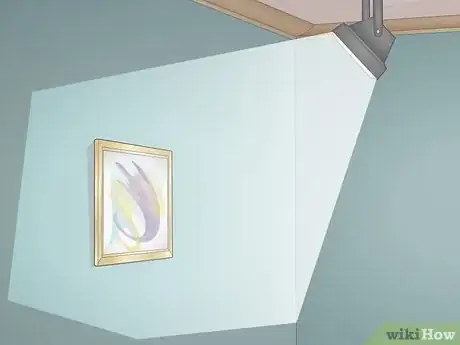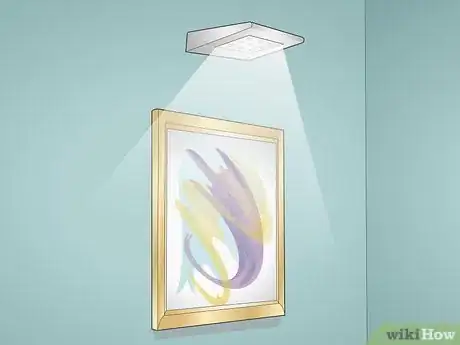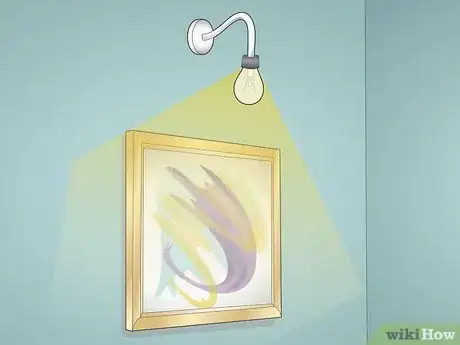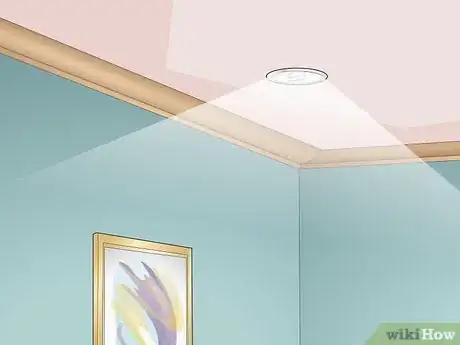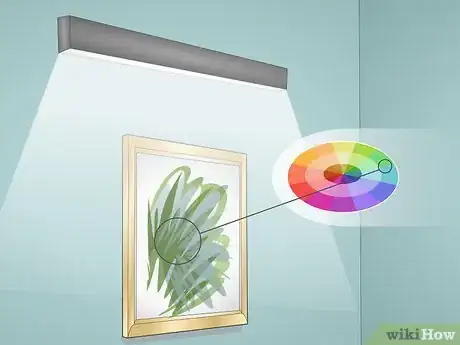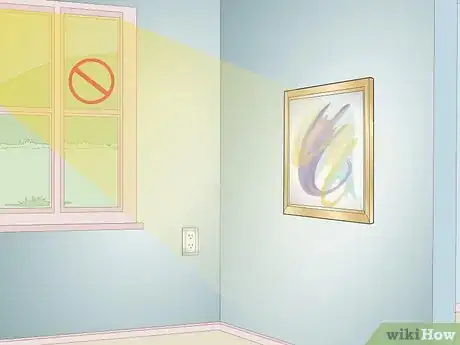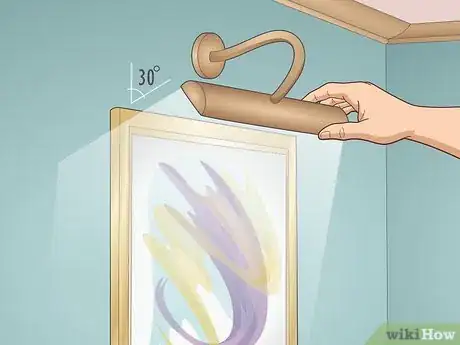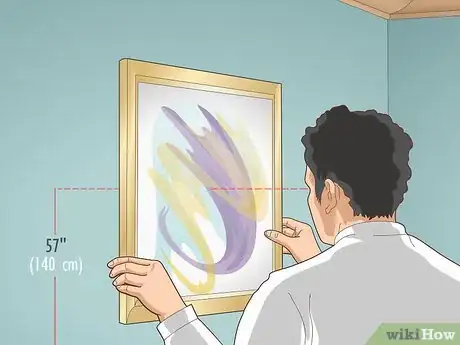This article was co-authored by Karen Parziale. Karen Parziale is a Home Stager, Home Organizer, and the Founder of The Real Estate Staging Studio based in Hoboken, New Jersey. Karen has over 15 years of home staging and decorating experience and has staged over 5,000 homes. She specializes in project management, space planning, material selections, and builder, architect, and client relationships.
There are 10 references cited in this article, which can be found at the bottom of the page.
This article has been viewed 23,377 times.
When it comes to wall art, lighting can make all the difference! Choosing an appropriate lighting fixture can give your wall art the perfect spotlight it needs to stand out. The type of bulb and the temperature of its light will also make a difference—bright, white lights can add a more modern, gallery-like aesthetic to your home while warmer, more yellow lights can provide a cozy, intimate feel. How you display the artwork on the wall can complement and elevate your design scheme while ensuring the artwork’s colors stay vivid over time.
Steps
Choosing a Light Fixture
-
1Install track lighting for flexibility and a modern, industrial look. Track lights can slide along the installation beam, which is useful if you regularly change your art display or decide to move your art pieces around on the same wall. You'll need to consider the height of your ceiling before you install the track lighting to ensure the light hits the artwork at a 30-degree angle.[1]
- If your ceilings are 8 feet (2.4 m) high, install the track 24 inches (61 cm) away from the wall where the art is hanging.
- For a ceiling 10 feet (3.0 m) high, the track should be 33 inches (84 cm) away from the wall.
- For a ceiling 12 feet (3.7 m) high, place the track 51 inches (130 cm) away from the wall.
-
2Use a wall washer with multiple bulbs to evenly illuminate a large piece. A wall washer is a long strip of several small lights in a single unit. Washers are great for lighting wall art because each bulb ensures even light is projected onto the piece. You can either mount them from the ceiling near where it meets the wall or from the wall itself about 8 inches (20 cm) to 12 inches (30 cm) above the top of the artwork.[2]
- Wall washers mounted from the ceiling directly above the artwork are ideal for lighting artwork with lots of texture.
- If you want to use recessed washers in the ceiling, take the height into count. For example, if you have 8 ft (2.4 m) ceilings, mount the washing fixture 18 inches (46 cm) to 24 inches (61 cm) away from the wall so the light hits the artwork at a 30-degree angle.
Advertisement -
3Mount a picture light on top of art frames for an intimate viewing experience. Picture lights can be more inviting and cozy, which is ideal for a small den or family room. They typically use low-wattage lamps that will invite you to stand closer to the piece to look at it. A picture light won’t work if the art doesn’t have a sturdy frame that you can attach it to.[3]
- If you're a renter, this is a great option because it doesn't require cutting or drilling holes in the ceiling.
- Note that some picture lamps have cords, so you'll need an outlet nearby. Other types require batteries (typically AAA-size) that you'll need to replace as necessary.
- The shade size of the picture-light lamp should be at least 1/2 the width of the artwork (e.g., do not use a picture lamp that’s less than 12 inches (30 cm) long for a painting that’s 24 inches (61 cm) wide.[4]
Selecting the Bulb Type and Temperature
-
1Mimic a professional gallery with bright, white halogen lights. Most art galleries and museums use halogen lights because of their high color rendering index (CRI), which is a number that determines how correctly a light brings out the true color of an object. Halogen lights typically score the highest with a CRI of 95 to 100.[5]
- One downside to halogen bulbs is that they get extremely hot, so it’s important to keep them away from flammable materials and the painting itself.
- Halogen bulbs have an average lifespan of 2,000 hours, so you’ll need to replace them more often depending on how long you leave them on each day.
- Halogen bulbs are a great choice if you plan to install track lighting because it will be far enough from the painting to provide a spotlight and not so close that the heat might damage the painting.
-
2Use LED bulbs to showcase oil paintings while using less energy. Many galleries use LED bulbs because they emit a diffused, more uniform light that won’t cause uneven streaks and highlights on oil paintings. They’re the most energy-efficient bulb and last 10,000 to 25,000 hours (the longest lifespan of any type of bulb).[6]
- LED lights come in a variety of temperatures from warm white light to cool white and daylight.
- Consider using a dimmable LED bulb if you like the flexibility of highlighting or lowlighting your artwork.
-
3Choose an incandescent bulb for a warm, yellow light. Incandescent bulbs will highlight the red, yellow, gold, and orange tones in an art piece, which can also create a flattering contrast for blues and greens. They’re perfect for accenting artwork in a cozy bedroom, den, or dining room.[7]
- Incandescent bulbs typically come in 60, 70, or 100-watt varieties, so choose a wattage that’s higher than the other bulbs in the room to make the art piece pop.
- A disadvantage is that incandescent bulbs aren’t considered environmentally friendly—they produce a lot of heat (decreasing their already-short lifespan of 750 to 1,000 hours) and emit carbon dioxide.
-
4Flatter cool-toned artwork with compact fluorescent light (CFL) bulbs. CFL bulbs are the more energy-efficient version of traditional fluorescent and incandescent lights—a 23-watt CFL bulb will emit the same amount of light as a 100-watt incandescent bulb. The light tends to be on the cooler side, which is perfect if you have paintings with a lot of cool colors like green, blue, and purple.[8]
- While they can be more expensive than regular fluorescent bulbs, they’ll last about 9,000 hours.
- CFL bulbs also come in low color temperature ranges that emit warmer, yellowish light that flatters paintings with warm colors (red, orange, and yellow hues).
- A disadvantage of CFL bulbs is that they have a relatively low CRI compared to other bulbs (50 to 90), meaning it won’t render the colors as true as they’re meant to be.
- Note that CFL bulbs emit a small number of UV rays, so it’s best to only use CFL bulbs with art that’s framed with UV-filtering plexiglass.
-
5Pick a color temperature that complements the colors of the artwork. The color temperature of the bulb is reported in Kelvins. Look at the painting and assess whether you want to highlight the warm or cool tones (that is, red, yellow, and orange hues versus gree, blue, and purple tones). Look at the bulb's package to determine it's Kelvin value.[9]
- A low range (2700 to 3000K) emit a warmer light much like incandescent bulbs and will enhance red and yellow tones. Cool colors might look a little dull under this type of light.
- Higher values (3500 to 6500K) give off a brighter, white light that will bring out blues and greens in the artwork. At a very high level, reds, yellows, and oranges might look slightly distorted.
Displaying Artwork
-
1Place the artwork on a wall that isn’t exposed to sunlight. Sunlight can cause colors to dull over time, so hang your artwork on an interior wall that doesn’t get any sunlight throughout the day. If this isn’t an option, use curtains to protect your artwork from the strong morning and afternoon light.[10]
- Another option is to frame the artwork with UV-filtering acrylic plexiglass instead of regular glass.
- For unframed paintings, purchase UV-protecting varnish from any art supply store and spray it onto the painting.
-
2Adjust the light so it hits the art at a 30-degree angle. Whether you’re using recessed pendants or surface-mounted lights, the light should hit the artwork at a 30-degree angle. Increase the angle to 35 degrees to highlight any textural aspects of the art—just don’t go over a 45-degree angle because it will cause a distracting glare either from the frame’s glass or the from the artwork’s varnish.[11]
- Lighting a piece from a 10-degree angle is too close and may end up casting shadows onto the art.
- If you’re using a picture light, choose one that sticks out a little from the painting so it’s not being lit from directly overhead. However, feel free to break the 30-degree rule if you like the look of direct overhead lighting on a particular piece of art.
-
3Hang artwork at eye level or 57 inches (140 cm) from the center to the floor. Galleries and museums abide by this rule because it’s the most comfortable viewing angle for most people. Use a tape measure and pencil to mark a spot 57 inches (140 cm) from the floor. Hold the painting up to the wall to determine where exactly you need to hang it so that point meets the center of the painting.[12]
- Note that you will not be putting the nail into the center marking—you’ll need to make a hole higher on the wall depending on the length of the wire hanger.
- If you’re hanging artwork over a couch, the bottom of the painting should be 8 inches (20 cm) to 10 inches (25 cm) above the back of the couch.
- However, feel free to break this rule as you like by leaning a tall painting against the wall, hanging a small painting over a doorway, or hanging it higher to create the illusion of tall ceilings.[13]
Expert Q&A
-
QuestionCan I just use any kind of lights for this?
 Karen ParzialeKaren Parziale is a Home Stager, Home Organizer, and the Founder of The Real Estate Staging Studio based in Hoboken, New Jersey. Karen has over 15 years of home staging and decorating experience and has staged over 5,000 homes. She specializes in project management, space planning, material selections, and builder, architect, and client relationships.
Karen ParzialeKaren Parziale is a Home Stager, Home Organizer, and the Founder of The Real Estate Staging Studio based in Hoboken, New Jersey. Karen has over 15 years of home staging and decorating experience and has staged over 5,000 homes. She specializes in project management, space planning, material selections, and builder, architect, and client relationships.
Home Stager & Interior Designer You really want to be mindful of the artwork itself. Many kinds of light will actually damage original art, so you really have to make sure that you're choosing quality lighting. If the artwork is expensive or it has unique sentimental value to you, you may want to invest in some museum-quality lights. If it's just inexpensive art that you don't care super deeply about, you can absolutely use whatever light you'd like.
You really want to be mindful of the artwork itself. Many kinds of light will actually damage original art, so you really have to make sure that you're choosing quality lighting. If the artwork is expensive or it has unique sentimental value to you, you may want to invest in some museum-quality lights. If it's just inexpensive art that you don't care super deeply about, you can absolutely use whatever light you'd like.
Warnings
- If you want to install track lights, wall washers, or recessed lights, it’s best to hire an electrician to install it for you.⧼thumbs_response⧽
References
- ↑ https://www.architecturaldigest.com/story/how-to-light-art
- ↑ https://www.architecturaldigest.com/story/how-to-light-art
- ↑ https://youtu.be/tdulE4jTbek?t=149
- ↑ https://youtu.be/tdulE4jTbek?t=149
- ↑ https://www.lrc.rpi.edu/programs/nlpip/lightinganswers/mr16/advantages.asp
- ↑ https://www.architecturaldigest.com/story/how-to-light-art
- ↑ https://youtu.be/tdulE4jTbek?t=96
- ↑ https://www.nitpickyartist.com/types-of-lights.html
- ↑ https://smarterhouse.org/content/choosing-right-bulb



